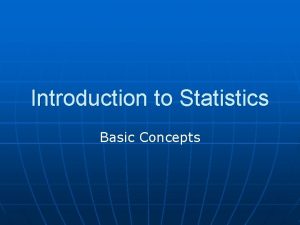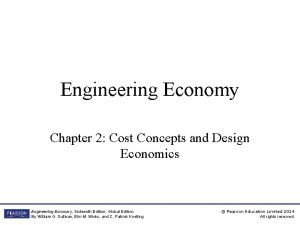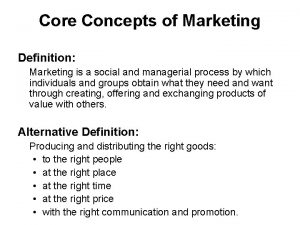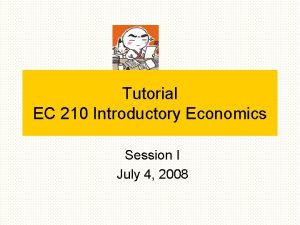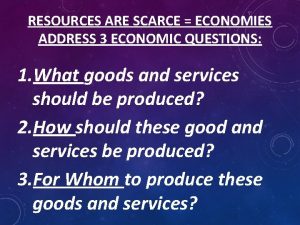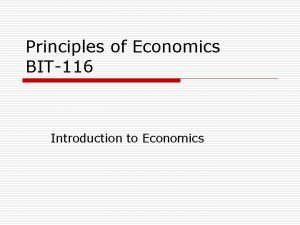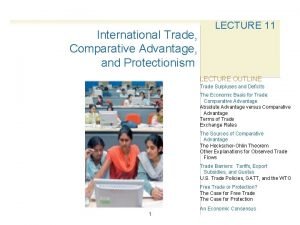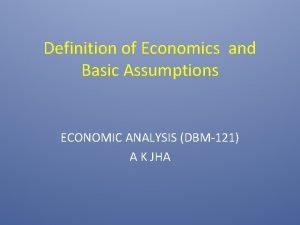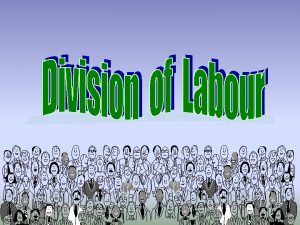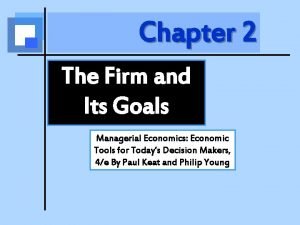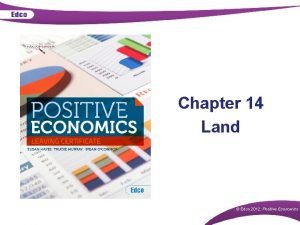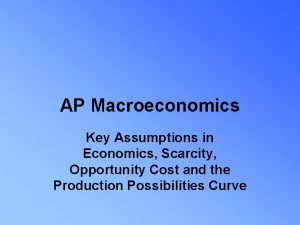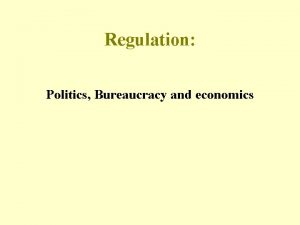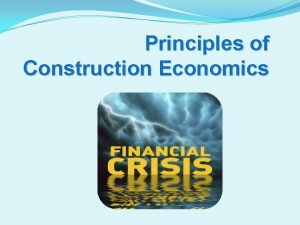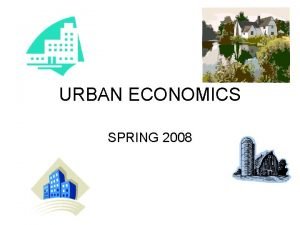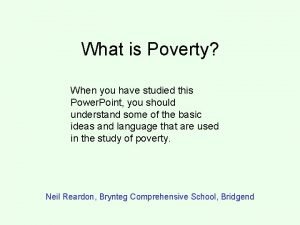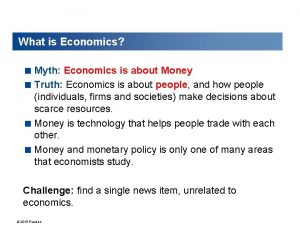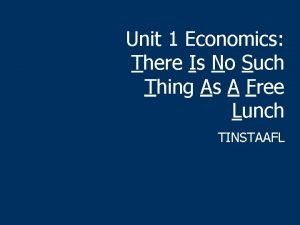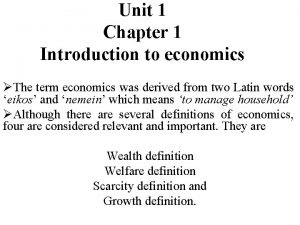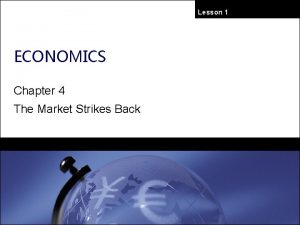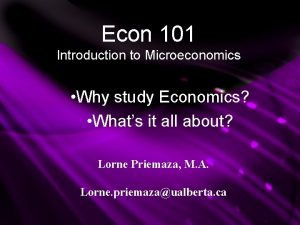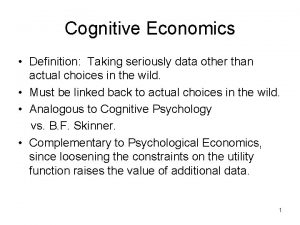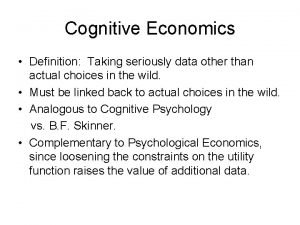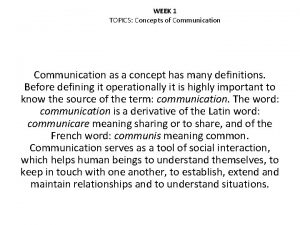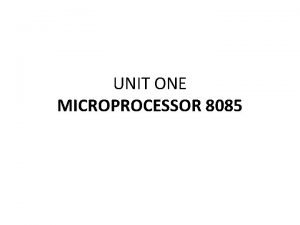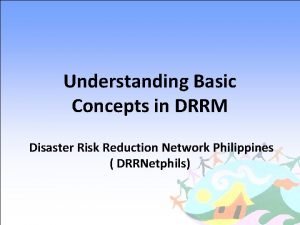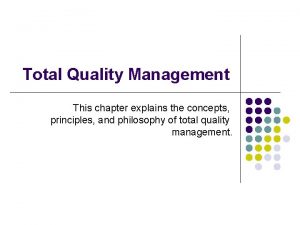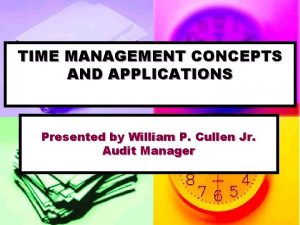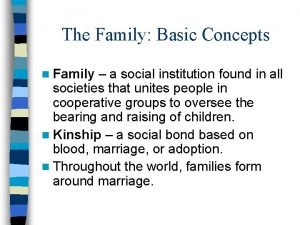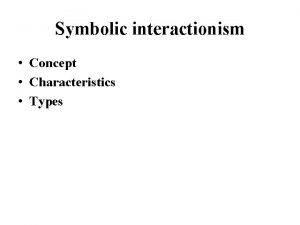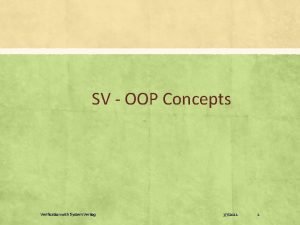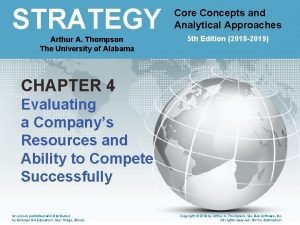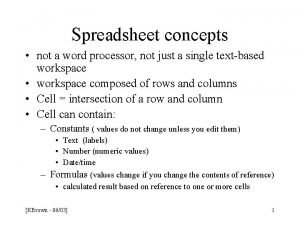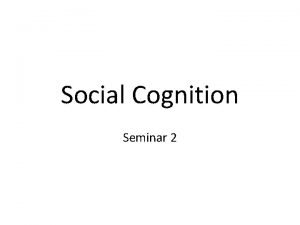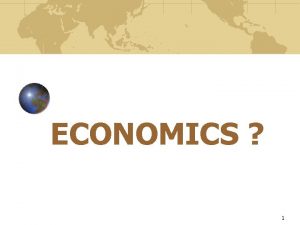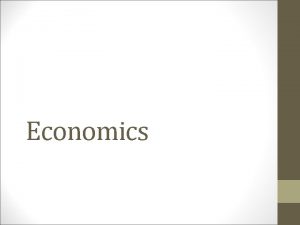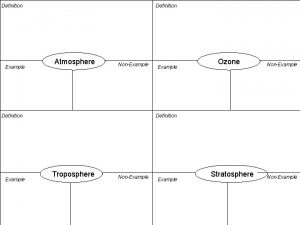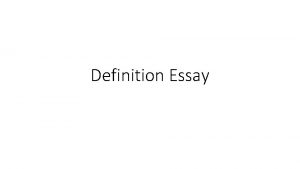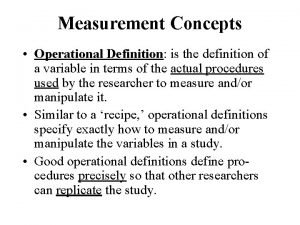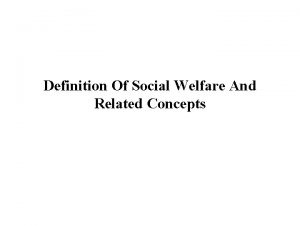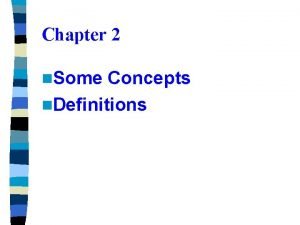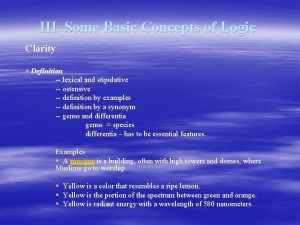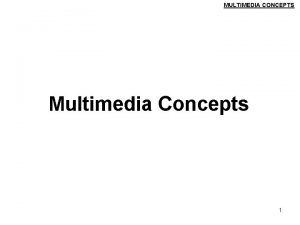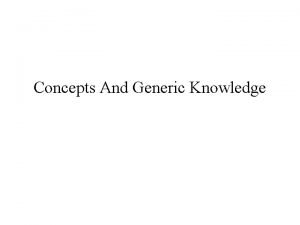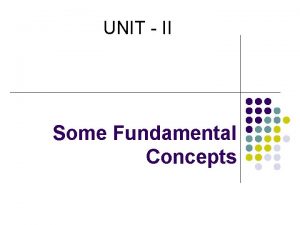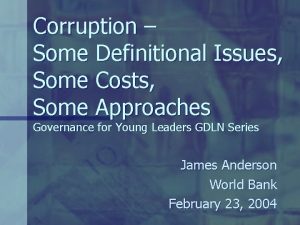Some Economics Concepts Definition of economics n the















































































































- Slides: 111

Some Economics Concepts

Definition of economics n the study of how individuals and societies use limited resources to satisfy unlimited wants.

Fundamental economic problem n n n scarcity. Economics is the study of how individuals and economies deal with the fundamental problem of scarcity. As a result of scarcity, individuals and societies must make choices among competing alternatives.

Opportunity Cost • Economics is all about trade offs • Because of scarcity our choices require that in order to get something we must give something up • What you give up to get something else is your opportunity cost.

Rational self-interest n n When an individual makes a choice they go through a cost-benefit evaluation This is the idea that an individual compares the opportunity costs to the benefits and chooses the option which benefits them most (rationality)

Positive and normative analysis n positive economics n n n attempt to describe how the economy functions relies on testable hypotheses normative economics n relies on value judgements to evaluate or recommend alternative policies.

Economic methodology n scientific method n n observe a phenomenon, make simplifying assumptions and formulate a hypothesis, generate predictions, and test the hypothesis.

Efficiency n n Economists strive to achieve 100% efficiency known as Parato Efficiency In Parato Efficiency society is 100 $ efficient and there is no way to improve on persons well being without reducing another ones.

Microeconomics

Microeconomics vs. macroeconomics n n microeconomics - the study of individual economic decisions and choices and how they effect individual markets Macroeconomics - brings all the individual markets together and observes the behavior of the entire market

Algebra and graphical analysis n direct relationship

Direct relationship

Inverse relationship

Linear relationships n A linear relationship possesses a constant slope, defined as:

Demand Supply

Markets n n In a market economy, the price of a good is determined by the interaction of demand supply A market for a good is comprised of all the buyers and sellers of that particular good

Demand n n A relationship between price and quantity demanded in a given time period The quantity demanded is the amount of good buyers are willing to purchase at a set price

Demand schedule

Demand curve

Law of demand n n An inverse relationship exists between the price of a good and the quantity demanded in a given time period, Reasons: n n n Related goods Income Tastes Expectations Number of buyers

Income n n n If someone's income is lowered they will be less willing to spend money on goods and vice versa Normal goods Inferior goods

Income and demand: normal goods n A good is a normal good if an increase in income results in an increase in the demand for the good.

Income and demand: inferior goods n A good is an inferior good if an increase in income results in a reduction in the demand for the good.

Price of Related Goods n n Substitutes – a good which causes a decline in the demand of another good if its price declines Complement – a good which causes an increase in the demand of another good if its price declines

Change in the price of a substitute good n Price of coffee rises:

Change in the price of a complementary good n Price of DVDs rises:

Tastes n The idea that if an buyers perception of benefits from buying a good changes so will the buyers willingness to purchase the good

Expectations n n A higher expected future price will increase current demand. A lower expected future price will decrease current demand. A higher expected future income will increase the demand for all normal goods. A lower expected future income will reduce the demand for all normal goods.

Number of Buyers n n The market demand curve consists of all the individual demand curves put together So if there are more consumers in the market demand will increase

Change in quantity demanded vs. change in demand Change in quantity demanded Change in demand

Market demand curve n Market demand is the horizontal summation of individual consumer demand curves

Supply n n the relationship that exists between the price of a good and the quantity supplied in a given time period Quantity supplied is the amount that a seller is able to produce for a set price

Supply schedule

Demand curve

Law of supply n A direct relationship exists between the price of a good and the quantity supplied in a given time period

Reason for law of supply n The law of supply is the result of the law of increasing cost. n n As the quantity of a good produced rises, the marginal opportunity cost rises. Sellers will only produce and sell an additional unit of a good if the price rises above the marginal opportunity cost of producing the additional unit.

Change in supply vs. change in quantity supplied Change in supply Change in quantity supplied

Individual firm and market supply curves n The market supply curve is the horizontal summation of the supply curves of individual firms. (This is equivalent to the relationship between individual and market demand curves. )

Determinants of supply n n n Price received by supplier Input price technology the expectations of producers the number of producers Relative Goods

Price Received by Supplier n n This is the law of supply The more money the supplier receives for the good he’s selling the more willing he/she will be to sell it

Price of resources (Input Price) n n Inputs are the goods the supplier has to purchase in order to produce the supply As the price of a resource rises, profitability declines, leading to a reduction in the quantity supplied at any price.

Technological improvements n Technological improvements (and any changes that raise the productivity of labor) lower production costs and increase profitability.

Expectations and supply n n An increase in the expected future price of a good or service results in a reduction in current supply. The supplier will hold off on selling his goods if he can sell them for a greater profit later.

Increase in the Number of Sellers

Prices of other goods n n n More than one firm produces and sells the same good or a relative good Because of this firms compete with each other to sell more goods and in order to do so they have to lower their prices below that of their competition Without this effect all markets would be monopolistic and we would all be screwed

Equilibrium…the fun never stops

Market equilibrium

Price above equilibrium n If the price exceeds the equilibrium price, a surplus occurs:

Price below equilibrium n If the price is below the equilibrium a shortage occurs:

Consumer and Producer Surplus n n Consumer surplus – the utility (or level of satisfaction) a buyer receives by being able to purchase a product for a price less then the maximum they were willing to pay Producer surplus – the amount that producers benefit by selling at a market price which is greater than the minimum they would be willing to sell for

Consumer/Producer Surplus Visualized

Consumer surplus n n Individuals buy an item only if they receive a net gain from the purchase (i. e. , total benefit exceeds opportunity cost. ) This net gain is called “consumer surplus. ”

Example n Suppose that an individual buys 10 units of a good when the price is $5

Benefits and cost of first unit • Benefit = blue + green rectangles (=$9) • Cost = green rectangle (=$5) • Consumer surplus = blue rectangle (=$4)

Total benefit to consumer

Total cost to consumer

Consumer surplus

Demand rises

Demand falls

Supply rises

Supply falls

Price ceiling n n Price ceiling - legally mandated maximum price Purpose: keep price below the market equilibrium price

Price ceiling (continued)

Price floor n n price floor - legally mandated minimum price designed to maintain a price above the equilibrium level

Price floor (continued)

Elasticity

Elasticity n n A measure of the responsiveness of one variable (quantity demanded or supplied) to a change in another variable (price) Most commonly used elasticity: price elasticity of demand, defined as: Price elasticity of demand =

Price elasticity of demand n Demand is said to be: n n n elastic when Ed > 1, unit elastic when Ed = 1, and inelastic when Ed < 1.

Perfectly elastic demand

Perfectly inelastic demand

Elasticity & slope n n n a price increase from $1 to $2 represents a 100% increase in price, a price increase from $2 to $3 represents a 50% increase in price, a price increase from $3 to $4 represents a 33% increase in price, and a price increase from $10 to $11 represents a 10% increase in price. Notice that, even though the price increases by $1 in each case, the percentage change in price becomes smaller when the starting value is larger.

Elasticity along a linear demand curve

Elasticity along a linear demand curve

Determinants of price elasticity Price elasticity is relatively high when: n close substitutes are available n the good or service is a large share of the consumer's budget (necessities) n a longer time period is considered (time horizon)

Price elasticity of supply

Perfectly inelastic supply

Perfectly elastic supply

Determinants of supply elasticity n n n Ease of Entry and Exit Scarce Resources Time Horizon

Elasticity and total revenue n n Total revenue = price x quantity What happens to total revenue if the price rises? Price elasticity of demand =

Elasticity and TR (cont. ) Price elasticity of demand = n A reduction in price will lead to: n n n an increase in TR when demand is elastic. a decrease in TR when demand is inelastic. an unchanged level of total revenue when demand is unit elastic.

Elasticity and TR (cont. ) Price elasticity of demand = n In a similar manner, an increase in price will lead to: n n n a decrease in TR when demand is elastic. an increase in TR when demand is inelastic. an unchanged level of total revenue when demand is unit elastic.

…. . . Let’s Stick to the Nonconfusing Example

Everyone's Favorite…Taxes!!!!

Tax incidence n n n distribution of the burden of a tax depends on the elasticities of demand supply. When supply is more elastic than demand, consumers bear a larger share of the tax burden. Producers bear a larger share of the burden of a tax when demand is more elastic than supply.

Costs and production

Production possibilities curve n Assumptions: n n A fixed quantity and quality of available resources A fixed level of technology

Specialization and trade n Adam Smith – economic growth is caused by increased specialization and division of labor.

Specialization and trade n n As noted by Adam Smith, specialization and trade are inextricably linked. Adam Smith used this argument to support free trade among nations.

Absolute and comparative advantage n n Absolute advantage – an individual (or country) is more productive than other individuals (or countries). Comparative advantage – an individual (or country) may produce a good at a lower opportunity cost than can other individuals (or countries).

Example: U. S. and Japan n Suppose the U. S. and Japan produce only two goods: CD players and wheat.

Absolute advantage? n Who has an absolute advantage in producing each good?

Comparative advantage? n Who has a comparative advantage in producing each good?

Gains from trade n n n Opportunity cost of CD player in U. S. = 2 units of wheat Opportunity cost of CD player in Japan = 4/3 unit of wheat If Japan produces and trades each CD player to the U. S. for more than 4/3 of a unit of wheat but less than 2 units of wheat, both the U. S. and Japan gain from trade and can consume more goods than they could produce by themselves.

Gains from trade (continued) n n Note that the U. S. has a comparative advantage in producing wheat. Countries always expand their consumption possibilities by engaging in trade (since they acquire goods at a lower opportunity cost than if they produced themselves).

Free trade? n If each country specializes in the production of those goods in which it possesses a comparative advantage and trades with other countries, global output and consumption is increased.

Robinson and Crusoe? Really USAD……Really?

�Profit Motive and Behavior Firms n n n Profit = total revenue – total cost (costs will likely only include only monetary expenses) Total cost is comprised of expenses plus all monetary opportunity costs

Different Costs n n The costs that do not depend on production and can’t change in the short run are called fixed costs However costs that can be varied in the short run are called variable costs

Marginal Cost n n Notice in figure 23 that when you go down 1 row there are 50 more loaves of bread produced; however, there is an additional cost for producing more goods This increase in cost when producing an additional unit of output is called the marginal cost

How to find marginal cost n (increase in total cost) MC = ------------------(increase in quantity produced)

Law of Diminishing Returns n n Next notice that the maximum profit is made when marginal cost is equal to marginal revenue Think of the marginal cost as the opportunity cost for making an extra unit of good and the marginal revenue as the profit for making that extra unit

Law of Diminishing Returns n n as the level of a variable input rises in a production process in which other inputs are fixed, output ultimately increases by progressively smaller increments So this means that at some point it’s no longer productive to make that extra unit of good

Imperfect Markets

Monopolies n n A monopoly is an extreme case in which there is a market with only one producer Ownership Monopolies Government-Created Monopolies Natural Monopolies

Why Monopolies Are Bad? n Because the supplier can charge whatever amount he/she wants for the product and there is no competition to force the supplier to lower the prices on goods

Price discrimination n different customers are charged different prices for the same product, due to differences in price elasticity of demand higher prices for those customers who have the most inelastic demand lower prices for those customers who have a more elastic demand.

Price discrimination (cont. ) n n customers who are willing to pay the highest prices are charged a high price, and customers who are more sensitive to price differentials are charged a low price.

Next up…Oligopolies n n n An oligopoly is a market with very few suppliers Not quite as bad as a monopoly but still Example: OPEC (Organization of Petroleum Exporting Countries)

Creative Destruction n n A term coined by the Australian economist Joseph Schumpeter “creative destruction” states that as new industries surged, older industries grow more slowly, stagnate, and shrink

Market failures n Not all markets are perfect and sometimes a market failure will occur when externalities or breakdowns in the system of private property cause markets to deviate from the socially efficient outcome

Oh the Government n n Pork Barrel Politics – elected officials introduce projects that steer money into their of pockets Logrolling – vote trading within legislation
 Introduction to statistics and some basic concepts
Introduction to statistics and some basic concepts They say it only takes a little faith
They say it only takes a little faith Sometimes you win some
Sometimes you win some Cakes countable or uncountable
Cakes countable or uncountable Force and motion
Force and motion Some say the world will end in fire some say in ice
Some say the world will end in fire some say in ice Some say the world will end in fire some say in ice
Some say the world will end in fire some say in ice Some trust in horses
Some trust in horses Fundamental economic concepts in managerial economics
Fundamental economic concepts in managerial economics Pearson engineering
Pearson engineering Fundamental concepts of managerial economics
Fundamental concepts of managerial economics Hát kết hợp bộ gõ cơ thể
Hát kết hợp bộ gõ cơ thể Slidetodoc
Slidetodoc Bổ thể
Bổ thể Tỉ lệ cơ thể trẻ em
Tỉ lệ cơ thể trẻ em Chó sói
Chó sói Tư thế worm breton
Tư thế worm breton Bài hát chúa yêu trần thế alleluia
Bài hát chúa yêu trần thế alleluia Các môn thể thao bắt đầu bằng tiếng chạy
Các môn thể thao bắt đầu bằng tiếng chạy Thế nào là hệ số cao nhất
Thế nào là hệ số cao nhất Các châu lục và đại dương trên thế giới
Các châu lục và đại dương trên thế giới Công của trọng lực
Công của trọng lực Trời xanh đây là của chúng ta thể thơ
Trời xanh đây là của chúng ta thể thơ Mật thư tọa độ 5x5
Mật thư tọa độ 5x5 Phép trừ bù
Phép trừ bù độ dài liên kết
độ dài liên kết Các châu lục và đại dương trên thế giới
Các châu lục và đại dương trên thế giới Thể thơ truyền thống
Thể thơ truyền thống Quá trình desamine hóa có thể tạo ra
Quá trình desamine hóa có thể tạo ra Một số thể thơ truyền thống
Một số thể thơ truyền thống Cái miệng nó xinh thế chỉ nói điều hay thôi
Cái miệng nó xinh thế chỉ nói điều hay thôi Vẽ hình chiếu vuông góc của vật thể sau
Vẽ hình chiếu vuông góc của vật thể sau Nguyên nhân của sự mỏi cơ sinh 8
Nguyên nhân của sự mỏi cơ sinh 8 đặc điểm cơ thể của người tối cổ
đặc điểm cơ thể của người tối cổ Ví dụ về giọng cùng tên
Ví dụ về giọng cùng tên Vẽ hình chiếu đứng bằng cạnh của vật thể
Vẽ hình chiếu đứng bằng cạnh của vật thể Vẽ hình chiếu vuông góc của vật thể sau
Vẽ hình chiếu vuông góc của vật thể sau Thẻ vin
Thẻ vin đại từ thay thế
đại từ thay thế điện thế nghỉ
điện thế nghỉ Tư thế ngồi viết
Tư thế ngồi viết Diễn thế sinh thái là
Diễn thế sinh thái là Các loại đột biến cấu trúc nhiễm sắc thể
Các loại đột biến cấu trúc nhiễm sắc thể Số nguyên là gì
Số nguyên là gì Tư thế ngồi viết
Tư thế ngồi viết Lời thề hippocrates
Lời thề hippocrates Thiếu nhi thế giới liên hoan
Thiếu nhi thế giới liên hoan ưu thế lai là gì
ưu thế lai là gì Sự nuôi và dạy con của hươu
Sự nuôi và dạy con của hươu Sự nuôi và dạy con của hổ
Sự nuôi và dạy con của hổ Hệ hô hấp
Hệ hô hấp Từ ngữ thể hiện lòng nhân hậu
Từ ngữ thể hiện lòng nhân hậu Thế nào là mạng điện lắp đặt kiểu nổi
Thế nào là mạng điện lắp đặt kiểu nổi Maastricht university school of business and economics
Maastricht university school of business and economics Econ213
Econ213 The core concepts of marketing
The core concepts of marketing Summary writing definition
Summary writing definition Definition of scarcity in economics
Definition of scarcity in economics Greek word of ekonomiks
Greek word of ekonomiks Trade-off vs opportunity cost
Trade-off vs opportunity cost Transferable economics definition
Transferable economics definition The basic economic problem results from scarcity.
The basic economic problem results from scarcity. Traditional economy definition economics
Traditional economy definition economics Principal definition economics
Principal definition economics Definition of managerial economics
Definition of managerial economics Definition of international trade
Definition of international trade Protectionism definition economics
Protectionism definition economics Equity economics definition
Equity economics definition Definition of collusion economics
Definition of collusion economics Traditional economy definition economics
Traditional economy definition economics Definition of economics by adam smith
Definition of economics by adam smith Demerits of division of labour
Demerits of division of labour Managerial economics define
Managerial economics define Goals of the firm
Goals of the firm Positive economics definition
Positive economics definition Positive economics definition
Positive economics definition Tinstaafl definition economics
Tinstaafl definition economics Regulator economics definition
Regulator economics definition Definition of building economics
Definition of building economics Sports economics definition
Sports economics definition Economic environment definition
Economic environment definition Economics definition
Economics definition Macroeconomics definition economics
Macroeconomics definition economics Traditional economy definition economics
Traditional economy definition economics Types of poverty in economics
Types of poverty in economics Definition of economics
Definition of economics Opportunity cost vs trade off
Opportunity cost vs trade off Wealth definition of economics
Wealth definition of economics Civics and economics
Civics and economics Chapter 4 lesson 1 what is demand
Chapter 4 lesson 1 what is demand Rationing device definition economics
Rationing device definition economics Cognitive economics definition
Cognitive economics definition Cognitive economics definition
Cognitive economics definition Data management concepts
Data management concepts Concepts of communication
Concepts of communication Virtualization concepts
Virtualization concepts Basic concepts of microprocessor
Basic concepts of microprocessor Compile and go loader scheme
Compile and go loader scheme Concepts of drrm
Concepts of drrm Six basic concepts of tqm
Six basic concepts of tqm Time management concept
Time management concept Threshold definition ap human geography
Threshold definition ap human geography Undergeneralization in language
Undergeneralization in language Concept about marriage
Concept about marriage Evolution of computer architecture
Evolution of computer architecture Terminology and concepts
Terminology and concepts Features of symbolic interactionism
Features of symbolic interactionism Oops in systemverilog
Oops in systemverilog A company's resources and capabilities represent
A company's resources and capabilities represent Spreadsheet concepts
Spreadsheet concepts Test case description
Test case description Cognitive psychology concepts
Cognitive psychology concepts
